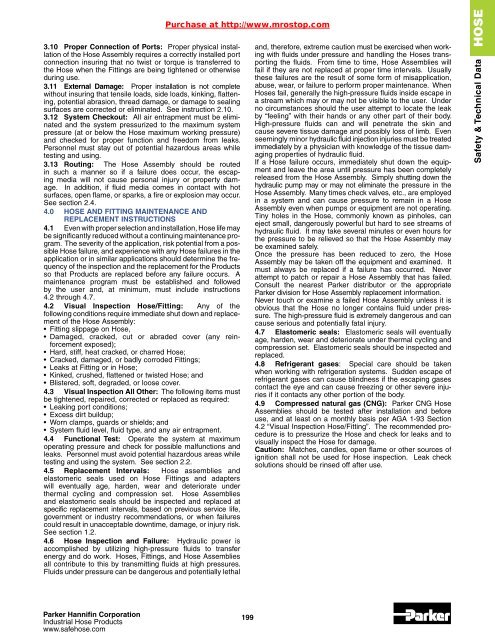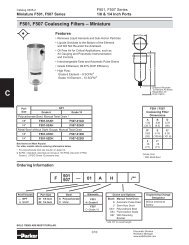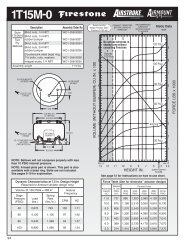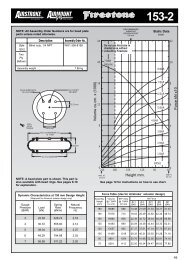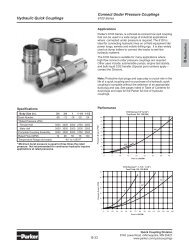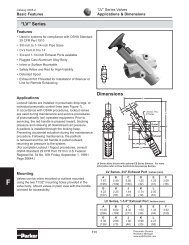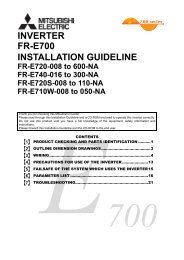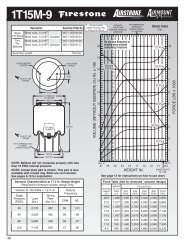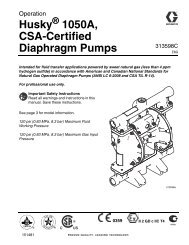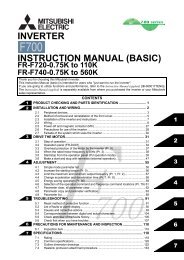HOSESafety & Technical Datapremature <strong>Hose</strong> failure. Any <strong>Hose</strong> that has been kinked orbent to a radius smaller than the minimum bend radius, andany <strong>Hose</strong> that has been cut or is cracked or is otherwise damaged,should be removed and discarded.2.12 Proper End Fitting: See instructions 3.2 through3.5. These recommendations may be substantiated bytesting to industry standards such as SAE J517 for hydraulicapplications, or MIL-A-5070, AS1339, or AS3517 for <strong>Hose</strong>sfrom <strong>Parker</strong>’s Stratoflex Products Division for aerospaceapplications.2.13 Length: When establishing a proper <strong>Hose</strong> length,motion absorption, <strong>Hose</strong> length changes due to pressure,and <strong>Hose</strong> and machine tolerances and movement must beconsidered.2.14 Specifications and Standards: When selecting <strong>Hose</strong>and Fittings, government, industry, and <strong>Parker</strong> specificationsand recommendations must be reviewed and followed asapplicable.2.15 <strong>Hose</strong> Cleanliness: <strong>Hose</strong> components may vary incleanliness levels. Care must be taken to insure that the<strong>Hose</strong> Assembly selected has an adequate level of cleanlinessfor the application.2.16 Fire Resistant Fluids: Some fire resistant fluids thatare to be conveyed by <strong>Hose</strong> require use of the same type of<strong>Hose</strong> as used with petroleum base fluids. Some such fluidsrequire a special <strong>Hose</strong>, while a few fluids will not work withany <strong>Hose</strong> at all. See instructions 2.5 and 1.5. The wrong<strong>Hose</strong> may fail after a very short service. In addition, all liquidsbut pure water may burn fiercely under certain conditions, andeven pure water leakage may be hazardous.2.17 Radiant Heat: <strong>Hose</strong> can be heated to destructionwithout contact by such nearby items as hot manifolds ormolten metal. The same heat source may then initiate a fire.This can occur despite the presence of cool air around the<strong>Hose</strong>.2.18 Welding or Brazing: When using a torch or arcwelderin close proximity to hydraulic lines, the hydraulic linesshould be removed or shielded with appropriate fire resistantmaterials. Flame or weld spatter could burn through the <strong>Hose</strong>and possibly ignite escaping fluid resulting in a catastrophicfailure. Heating of plated parts, including <strong>Hose</strong> Fittings andadapters, above 450°F (232°C) such as during welding, brazing,or soldering may emit deadly gases.2.19 Atomic Radiation: Atomic radiation affects all materialsused in <strong>Hose</strong> assemblies. Since the long-term effectsmay be unknown, do not expose <strong>Hose</strong> assemblies to atomicradiation.2.20 Aerospace Applications: The only <strong>Hose</strong> and Fittingsthat may be used for in flight aerospace applications are thoseavailable from <strong>Parker</strong>’s Stratoflex Products Division. Do notuse any other <strong>Hose</strong> or Fittings for in flight applications. Donot use any <strong>Hose</strong> or Fittings from <strong>Parker</strong>’s Stratoflex ProductsDivision with any other <strong>Hose</strong> or Fittings, unless expresslyapproved in writing by the engineering manager or chief engineerof Stratoflex Products Division and verified by the user’sown testing and inspection to aerospace industry standards.2.21 Unlocking Couplings: Ball locking couplings or othercouplings with disconnect sleeves can unintentionally disconnectif they are dragged over obstructions or if the sleeve isbumped or moved enough to cause disconnect. Threadedcouplings should be considered where there is a potential foraccidental uncoupling.3.0 HOSE AND FITTING ASSEMBLY ANDINSTALLATION INSTRUCTIONS3.1 Component Inspection: Prior to assembly,a careful examination of the <strong>Hose</strong> and Fittings must beperformed. All components must be checked for correct style,Purchase at http://www.mrostop.comsize, catalog number, and length. The <strong>Hose</strong> must be examinedfor cleanliness, obstructions, blisters, cover looseness,kinks, cracks, cuts or any other visible defects. Inspect theFitting and sealing surfaces for burrs, nicks, corrosion or otherimperfections. Do NOT use any component that displays anysigns of nonconformance.3.2 <strong>Hose</strong> and Fitting Assembly: Do not assemble a<strong>Parker</strong> Fitting on a <strong>Parker</strong> <strong>Hose</strong> that is not specifically listedby <strong>Parker</strong> for that Fitting, unless authorized in writing by theengineering manager or chief engineer of the appropriate<strong>Parker</strong> division. Do not assemble a <strong>Parker</strong> Fitting on anothermanufacturers <strong>Hose</strong> or a <strong>Parker</strong> <strong>Hose</strong> on another manufacturersFitting unless (i) the engineering manager or chief engineerof the appropriate <strong>Parker</strong> division approves the Assemblyin writing or that combination is expressly approved in theappropriate <strong>Parker</strong> literature for the specific <strong>Parker</strong> product,and (ii) the user verifies the Assembly and the applicationthrough analysis and testing. For <strong>Parker</strong> <strong>Hose</strong> that does notspecify a <strong>Parker</strong> Fitting, the user is solely responsible for theselection of the proper Fitting and <strong>Hose</strong> Assembly procedures.See instruction 1.4.The <strong>Parker</strong> published instructions must be followed forassembling the Fittings on the <strong>Hose</strong>. These instructions areprovided in the <strong>Parker</strong> Fitting catalog for the specific <strong>Parker</strong>Fitting being used, or by calling 1-800-CPARKER, or atwww.parker.com.3.3 Related Accessories: Do not crimp or swage any<strong>Parker</strong> <strong>Hose</strong> or Fitting with anything but the listed swage orcrimp machine and dies in accordance with <strong>Parker</strong> publishedinstructions. Do not crimp or swage another manufacturersFitting with a <strong>Parker</strong> crimp or swage die unless authorized inwriting by the engineering manager of chief engineer of theappropriate <strong>Parker</strong> division.3.4 Parts: Do not use any <strong>Parker</strong> Fitting part (including butnot limited to socket, shell, nipple, or insert) except with thecorrect <strong>Parker</strong> mating parts, in accordance with <strong>Parker</strong> publishedinstructions, unless authorized in writing by the engineeringmanager or chief engineer of the appropriate <strong>Parker</strong>division.3.5 Reusable/Permanent: Do not reuse any field attachable(reusable) <strong>Hose</strong> Fitting that has blown or pulled offa <strong>Hose</strong>. Do not reuse a <strong>Parker</strong> permanent <strong>Hose</strong> Fitting(crimped or swaged) or any part thereof. Complete <strong>Hose</strong>Assemblies may only be reused after proper inspection undersection 4.0. Do not assemble Fittings to any previously usedhydraulic <strong>Hose</strong> that was in service, for use in a fluid powerapplication.3.6 Pre-Installation Inspection: Prior to installation,a careful examination of the <strong>Hose</strong> Assembly must beperformed. Inspect the <strong>Hose</strong> Assembly for any damage ordefects. Do NOT use any <strong>Hose</strong> Assembly that displays anysigns of nonconformance.3.7 Minimum Bend Radius: Installation of a <strong>Hose</strong> at lessthan the minimum listed bend radius may significantly reducethe <strong>Hose</strong> life. Particular attention must be given to precludesharp bending at the <strong>Hose</strong> to Fitting juncture. Any bendingduring installation at less than the minimum bend radius mustbe avoided. If any <strong>Hose</strong> is kinked during installation, the <strong>Hose</strong>must be discarded.3.8 Twist Angle and Orientation: <strong>Hose</strong> Assembly installationmust be such that relative motion of machine componentsdoes not produce twisting.3.9 Securement: In many applications, it may benecessary to restrain, protect, or guide the <strong>Hose</strong> to protect itfrom damage by unnecessary flexing, pressure surges, andcontact with other mechanical components. Care must betaken to insure such restraints do not introduce additionalstress or wear points.198<strong>Parker</strong> Hannifin Corporation<strong>Industrial</strong> <strong>Hose</strong> Productswww.safehose.com
3.10 Proper Connection of Ports: Proper physical installationof the <strong>Hose</strong> Assembly requires a correctly installed portconnection insuring that no twist or torque is transferred tothe <strong>Hose</strong> when the Fittings are being tightened or otherwiseduring use.3.11 External Damage: Proper installation is not completewithout insuring that tensile loads, side loads, kinking, flattening,potential abrasion, thread damage, or damage to sealingsurfaces are corrected or eliminated. See instruction 2.10.3.12 System Checkout: All air entrapment must be eliminatedand the system pressurized to the maximum systempressure (at or below the <strong>Hose</strong> maximum working pressure)and checked for proper function and freedom from leaks.Personnel must stay out of potential hazardous areas whiletesting and using.3.13 Routing: The <strong>Hose</strong> Assembly should be routedin such a manner so if a failure does occur, the escapingmedia will not cause personal injury or property damage.In addition, if fluid media comes in contact with hotsurfaces, open flame, or sparks, a fire or explosion may occur.See section 2.4.4.0 HOSE AND FITTING MAINTENANCE ANDREPLACEMENT INSTRUCTIONS4.1 Even with proper selection and installation, <strong>Hose</strong> life maybe significantly reduced without a continuing maintenance program.The severity of the application, risk potential from a possible<strong>Hose</strong> failure, and experience with any <strong>Hose</strong> failures in theapplication or in similar applications should determine the frequencyof the inspection and the replacement for the Productsso that Products are replaced before any failure occurs. Amaintenance program must be established and followedby the user and, at minimum, must include instructions4.2 through 4.7.4.2 Visual Inspection <strong>Hose</strong>/Fitting: Any of thefollowing conditions require immediate shut down and replacementof the <strong>Hose</strong> Assembly:• Fitting slippage on <strong>Hose</strong>,• Damaged, cracked, cut or abraded cover (any reinforcementexposed);• Hard, stiff, heat cracked, or charred <strong>Hose</strong>;• Cracked, damaged, or badly corroded Fittings;• Leaks at Fitting or in <strong>Hose</strong>;• Kinked, crushed, flattened or twisted <strong>Hose</strong>; and• Blistered, soft, degraded, or loose cover.4.3 Visual Inspection All Other: The following items mustbe tightened, repaired, corrected or replaced as required:• Leaking port conditions;• Excess dirt buildup;• Worn clamps, guards or shields; and• System fluid level, fluid type, and any air entrapment.4.4 Functional Test: Operate the system at maximumoperating pressure and check for possible malfunctions andleaks. Personnel must avoid potential hazardous areas whiletesting and using the system. See section 2.2.4.5 Replacement Intervals: <strong>Hose</strong> assemblies andelastomeric seals used on <strong>Hose</strong> Fittings and adapterswill eventually age, harden, wear and deteriorate underthermal cycling and compression set. <strong>Hose</strong> Assembliesand elastomeric seals should be inspected and replaced atspecific replacement intervals, based on previous service life,government or industry recommendations, or when failurescould result in unacceptable downtime, damage, or injury risk.See section 1.2.4.6 <strong>Hose</strong> Inspection and Failure: Hydraulic power isaccomplished by utilizing high-pressure fluids to transferenergy and do work. <strong>Hose</strong>s, Fittings, and <strong>Hose</strong> Assembliesall contribute to this by transmitting fluids at high pressures.Fluids under pressure can be dangerous and potentially lethalPurchase at http://www.mrostop.comand, therefore, extreme caution must be exercised when workingwith fluids under pressure and handling the <strong>Hose</strong>s transportingthe fluids. From time to time, <strong>Hose</strong> Assemblies willfail if they are not replaced at proper time intervals. Usuallythese failures are the result of some form of misapplication,abuse, wear, or failure to perform proper maintenance. When<strong>Hose</strong>s fail, generally the high-pressure fluids inside escape ina stream which may or may not be visible to the user. Underno circumstances should the user attempt to locate the leakby “feeling” with their hands or any other part of their body.High-pressure fluids can and will penetrate the skin andcause severe tissue damage and possibly loss of limb. Evenseemingly minor hydraulic fluid injection injuries must be treatedimmediately by a physician with knowledge of the tissue damagingproperties of hydraulic fluid.If a <strong>Hose</strong> failure occurs, immediately shut down the equipmentand leave the area until pressure has been completelyreleased from the <strong>Hose</strong> Assembly. Simply shutting down thehydraulic pump may or may not eliminate the pressure in the<strong>Hose</strong> Assembly. Many times check valves, etc., are employedin a system and can cause pressure to remain in a <strong>Hose</strong>Assembly even when pumps or equipment are not operating.Tiny holes in the <strong>Hose</strong>, commonly known as pinholes, caneject small, dangerously powerful but hard to see streams ofhydraulic fluid. It may take several minutes or even hours forthe pressure to be relieved so that the <strong>Hose</strong> Assembly maybe examined safely.Once the pressure has been reduced to zero, the <strong>Hose</strong>Assembly may be taken off the equipment and examined. Itmust always be replaced if a failure has occurred. Neverattempt to patch or repair a <strong>Hose</strong> Assembly that has failed.Consult the nearest <strong>Parker</strong> distributor or the appropriate<strong>Parker</strong> division for <strong>Hose</strong> Assembly replacement information.Never touch or examine a failed <strong>Hose</strong> Assembly unless it isobvious that the <strong>Hose</strong> no longer contains fluid under pressure.The high-pressure fluid is extremely dangerous and cancause serious and potentially fatal injury.4.7 Elastomeric seals: Elastomeric seals will eventuallyage, harden, wear and deteriorate under thermal cycling andcompression set. Elastomeric seals should be inspected andreplaced.4.8 Refrigerant gases: Special care should be takenwhen working with refrigeration systems. Sudden escape ofrefrigerant gases can cause blindness if the escaping gasescontact the eye and can cause freezing or other severe injuriesif it contacts any other portion of the body.4.9 Compressed natural gas (CNG): <strong>Parker</strong> CNG <strong>Hose</strong>Assemblies should be tested after installation and beforeuse, and at least on a monthly basis per AGA 1-93 Section4.2 “Visual Inspection <strong>Hose</strong>/Fitting”. The recommended procedureis to pressurize the <strong>Hose</strong> and check for leaks and tovisually inspect the <strong>Hose</strong> for damage.Caution: Matches, candles, open flame or other sources ofignition shall not be used for <strong>Hose</strong> inspection. Leak checksolutions should be rinsed off after use.HOSESafety & Technical Data<strong>Parker</strong> Hannifin Corporation<strong>Industrial</strong> <strong>Hose</strong> Productswww.safehose.com199


